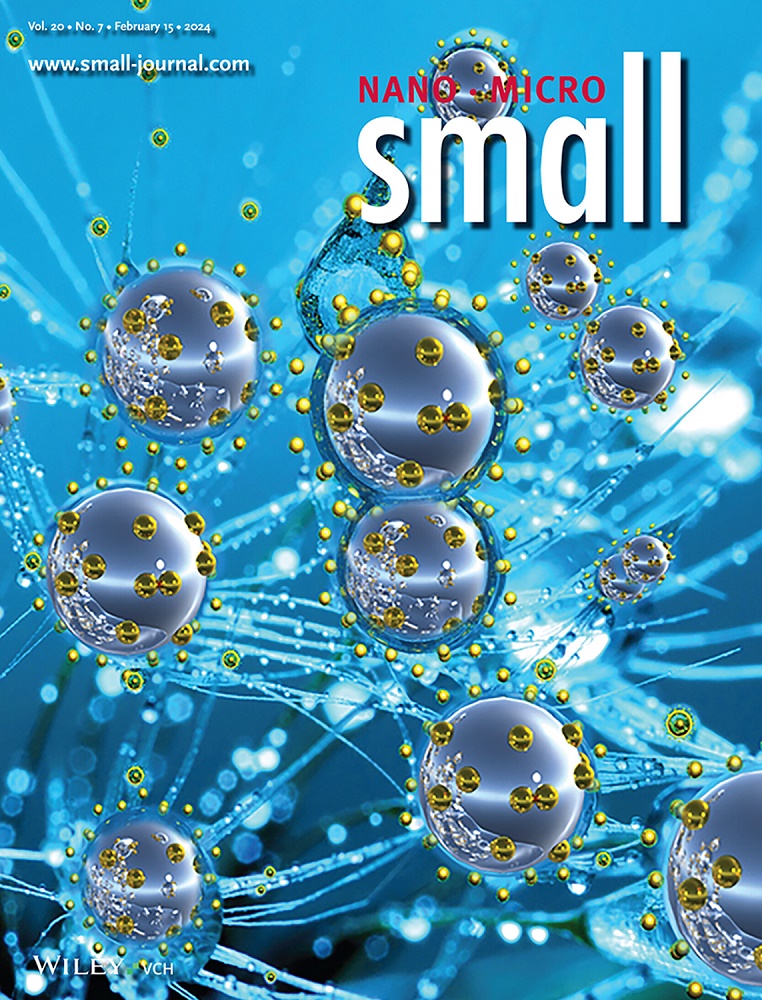Donor Planarity-Induced Molecular Twist in Donor-Acceptor-Donor AIEgens for Efficient NIR-II Fluorescence and Photothermal Therapy.
IF 12.1
2区 材料科学
Q1 CHEMISTRY, MULTIDISCIPLINARY
引用次数: 0
Abstract
Aggregation-induced emission (AIE) active donor-acceptor-donor (D-A-D) small molecules represent promising candidates for second near-infrared fluorescence imaging (NIR-II FLI) guided photothermal therapy (PTT) in anti-tumor applications. Trianiline and tetraphenylvinyl analogues are often used as electron donors, but may have limitations, such as moderate electron donor capabilities or suboptimal AIE properties. Herein, a molecular design strategy integrating π-conjugated planar electron donors are reported within a structurally twisted D-A-D framework to develop improved AIE-type NIR-II probes. Among the synthesized molecules, BBT-TIT, which incorporates the electron-rich TIT donor, simultaneously exhibits a high molar extinction coefficient (ɛ = 2.352 × 10⁴ M⁻¹ cm⁻¹) and significant aggregation-induced emission behavior (αAIE = 4.5). Notably, when formulated into water-soluble nanoparticles (BBT-TIT NPs), these particles demonstrated bright NIR-II fluorescence (FL) peaking at 1068 nm (QY = 1.85% in water) and efficient photothermal conversion (PCE η = 53.44%). In vivo, studies have successfully demonstrated the application of NPs in high-contrast NIR-II FL angiography and tumor imaging in living mice, as well as effective photothermal properties leading to significant tumor ablation. This study shows that combining selected planar electron donors with a twisted D-A-D architecture promises great potential for developing advanced AIE-active agents in NIR-II fluorescence imaging-guided photothermal therapy.用于NIR-II荧光和光热治疗的供体-受体-供体抗原中供体平面诱导的分子扭曲。
聚集诱导发射(AIE)活性供体-受体-供体(D-A-D)小分子是第二次近红外荧光成像(NIR-II FLI)引导光热治疗(PTT)抗肿瘤应用的有希望的候选者。三苯胺和四苯基乙烯类似物通常用作电子给体,但可能有局限性,例如中等电子给体能力或次优AIE性质。本文报道了一种在结构扭曲的D-A-D框架内整合π共轭平面电子给体的分子设计策略,以开发改进的ae型NIR-II探针。在合成的分子中,包含富电子的TIT供体的BBT-TIT同时表现出高的摩尔消光系数(ν = 2.352 × 10⁴M⁻¹cm⁻¹)和显著的聚集诱导发射行为(αAIE = 4.5)。值得注意的是,当配制成水溶性纳米颗粒(BBT-TIT NPs)时,这些颗粒在1068 nm处表现出明亮的NIR-II荧光(FL)峰(在水中QY = 1.85%)和高效的光热转化(PCE η = 53.44%)。在体内,研究已经成功地证明了NPs在活体小鼠高对比度NIR-II FL血管造影和肿瘤成像中的应用,以及有效的光热特性,导致显著的肿瘤消融。该研究表明,将选定的平面电子给体与扭曲的D-A-D结构相结合,在NIR-II荧光成像引导光热治疗中开发先进的aie活性药物具有很大的潜力。
本文章由计算机程序翻译,如有差异,请以英文原文为准。
求助全文
约1分钟内获得全文
求助全文
来源期刊

Small
工程技术-材料科学:综合
CiteScore
17.70
自引率
3.80%
发文量
1830
审稿时长
2.1 months
期刊介绍:
Small serves as an exceptional platform for both experimental and theoretical studies in fundamental and applied interdisciplinary research at the nano- and microscale. The journal offers a compelling mix of peer-reviewed Research Articles, Reviews, Perspectives, and Comments.
With a remarkable 2022 Journal Impact Factor of 13.3 (Journal Citation Reports from Clarivate Analytics, 2023), Small remains among the top multidisciplinary journals, covering a wide range of topics at the interface of materials science, chemistry, physics, engineering, medicine, and biology.
Small's readership includes biochemists, biologists, biomedical scientists, chemists, engineers, information technologists, materials scientists, physicists, and theoreticians alike.
 求助内容:
求助内容: 应助结果提醒方式:
应助结果提醒方式:


